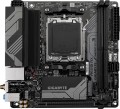Chipset
The chipset model installed in the motherboard. AMD's current chipset models are
B450,
A520,
B550,
X570,
A620,
B650,
B650E,
X670,
X670E,
B840,
B850,
X870,
X870E. For Intel, in turn, the list of chipsets looks like this:
X299,
H410,
B460,
H470,
Z490,
H510,
B560,
H570,
Z590,
H610,
B660,
H670,
Z690,
B760,
Z790,
H810,
B860,
Z890.
A chipset is a set of chips on the motherboard through which the individual components of the system inter
...act directly: the processor, RAM, drives, audio and video adapters, network controllers, etc. Technically, such a set consists of two parts — the north and south bridges. The key element is the northbridge, it connects the processor, memory, graphics card and the southbridge (together with the devices it controls). Therefore, it is often the name of the north bridge that is indicated as the chipset model, and the south bridge model is specified separately (see below); it is this scheme that is used in traditional layout motherboards, where bridges are made in the form of separate microcircuits. There are also solutions where both bridges are combined in one chip; for them, the name of the entire chipset can be indicated.
Anyway, knowing the chipset model, you can find various additional data on it — from general reviews to special instructions. An ordinary user, usually, does not need such information, but it can be useful for various professional tasks.M.2 version
The version of the M.2 interface determines both the maximum data transfer rate and the supported devices that can be connected via physical M.2 connectors (see the corresponding paragraph).
The version of the M.2 interface in the specifications of motherboards is usually indicated by the number of connectors themselves and by the PCI-E revision provided for in each of them. For example, the entry “3x4.0” means three connectors capable of supporting PCI-E 4.0; and the designation “2x5.0, 1x4.0” means a trio of connectors, two of which support PCI-E 4.0, and another one supports PCI-E 5.0.
USB 2.0
The number of USB 2.0 connectors installed on the back of the motherboard.
Recall that USB is the most popular modern connector for connecting various external peripherals — from keyboards and mice to specialized equipment. And USB 2.0 is the oldest version of this interface that is relevant today; it is noticeably inferior to the newer USB 3.2 both in terms of speed (up to 480 Mbps), and in terms of power supply and additional functionality. On the other hand, even such characteristics are often enough for undemanding peripherals (like the same keyboards / mice); and devices of newer versions can be connected to the connectors of this standard — there would be enough power supply. So this version of USB is still found in modern motherboards, although there are fewer and fewer new models with USB 2.0 connectors.
Note that in addition to the connectors on the rear panel, connectors on the board itself (more precisely, ports on the PC case connected to such connectors) can also provide a USB connection. See below for more on this.
USB 3.2 gen1
The number of native USB 3.2 gen1 connectors provided on the back of the motherboard. In this case, traditional, full-size USB A ports are meant.
USB 3.2 gen1(formerly known as USB 3.1 gen1 and USB 3.0) is a direct successor and development of the USB 2.0 interface. The main differences are a 10-fold increase in the maximum data transfer rate — 4.8 Gbps — as well as higher power supply, which is important when connecting several devices to one port through a splitter (hub). At the same time, peripherals of other versions can be connected to this connector.
The more connectors provided in the design, the more peripheral devices can be connected to the motherboard without the use of additional equipment (USB splitters). There are boards on the market that have
more than 4 USB 3.2 gen1 ports on the back panel. At the same time, we note that in addition to the connectors on the rear panel, connectors on the board itself (more precisely, ports on the case connected to such connectors) can also provide a USB connection. See below for more on this.
BIOS FlashBack
Motherboards that support
BIOS FlashBack provide the ability to flash or restore the BIOS without a processor, video card or memory. The main purpose of the function is to provide users with the ability to update the BIOS in cases where the current version is incompatible with the installed processor or other computer components, which may lead to the inability to start the system. As a rule, the motherboard provides for this a USB connector for a flash drive and a special button (usually labeled BIOS Flashback) - pressing it initiates the update process.
On a separate line, we note that the BIOS FlashBack function can be called differently depending on the manufacturer: in motherboards from ASRock and Asus - BIOS FlashBack, from Gigabyte - Q-Flash Plus, from MSI - Flash BIOS, etc.

